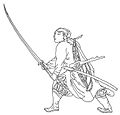- Changdao
-
This article is about the sword. For the county, see Changdao County.
Changdao (simplified Chinese: 长刀; traditional Chinese: 長刀; literally "long knife") was a type of anti-cavalry sword used in China during the Ming Dynasty. Sometimes called Miao dao (a similar but more recent weapon), the blade very much resembles a Japanese ōdachi. This weapon was adopted by General Qi Jiguang, who acquired a Kage-ryū (Aizu) manual from Japanese wokou, studied and modified it for his troops and used against enemies on the Mongol border circa 1560. It replaced the zhǎn mǎ dāo as a "horse slaying" weapon; if the Japanese blades were derivatives of the zhǎnmǎdāo, the changdao would effectively be a third-generation replacement of the original sword. At the time of General Qi it had a specified length of 1.95 meters, similar to the Japanese ōdachi. Its handle was long, apparently slightly more than one-third of its total length, and its curve shallower than that of Japanese swords. Commanding up to 100,000 troops on the Mongol border, General Qi found this weapon so effective that up to forty percent of his commandos had it as a weapon; it stayed in service throughout the late Ming dynasty.
See also
Types of Chinese weapons Short Swords Long Swords Polearms Guandao 關刀 · Ge (Dagger-Axe) 戈 · Gun 棍 · Ji 戟 · Nangun 南棍 · Podao 朴刀 · Qiang 槍 · Hongyingqiang 紅纓槍 · Yueya Chan (Monk's Spade) 月牙鏟Roped/Chained Liuxing Chui (Meteor Hammer) 流星錘 · Sheng Biao (Rope Dart) 繩鏢 · Jiujie bian (nine section whip) 九節鞭 · Sanjie Gun 三節棍 · Shuangjie Gun 雙節棍Projectile Handheld Chui 錘 · Emeici 峨嵋刺 · Lujiao Dao (Deer Horn Knives) 鹿角刀 · Hook Sword 鉤 · Ji Lian 鷄鐮 · Fenghuo Lun 風火輪
This article related to weaponry is a stub. You can help Wikipedia by expanding it.

